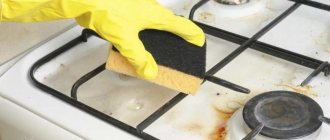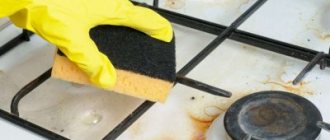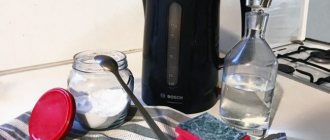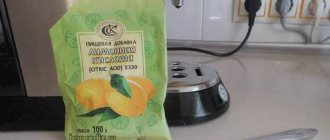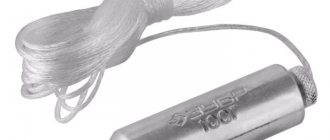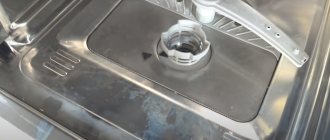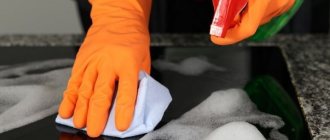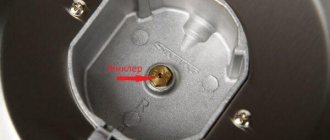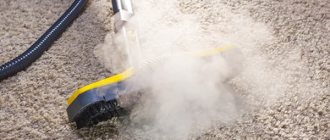One of the latest innovations among household products - a thermopot - certainly made a splash when it appeared on the market and eased the everyday worries of many housewives. But, like any other electrical appliance that comes into contact with water, it requires regular cleaning to remove limescale deposits that appear over time. How to clean a thermopot from scale at home? We have selected the most popular methods and popular tips with which you can easily cope with this trouble.
How to clean a thermopot from scale at home quickly and effectively - top 20 products
Having even a brand new device in use, you can observe how, after some time, white stains appear on its walls. This means that it’s time to clean the thermopot from scale. How and by what means can this be done at home?
Folk remedies
There are quite a few simple and effective ways to clean the device using folk remedies. Using the methods suggested below, you will effectively and completely safely remove all types of contaminants.
Vinegar
You can clean the thermopot from heavy scale using table vinegar. This is an effective remedy in combating limescale, in addition, acetic acid can cope with any, even the oldest deposits that may remain on the heating elements. To do this, mix the solution in a ratio of 2 liters of water to 100 milliliters of vinegar, pour it into the device and boil. Leave to cool completely and then rinse the device thoroughly.
Soda
A small deposit that has formed on the surface of the thermopot can be cleaned with soda. Dilute 2 dessert spoons of the product in 2 liters of water, pour the resulting solution into the container of the device and boil. After waiting for complete cooling, drain and thoroughly rinse the inner flask of all residues.
Lemon acid
If the plaque has acquired a dense sediment, you can clean the thermostat with citric acid. Since this is a fairly popular remedy, getting rid of scale will not be difficult. Add a tablespoon of crystalline substance to 1 liter of water and bring to a boil, drain the solution, removing the residue with a sponge. Rinse the container with clean water.
Soda + Citric acid
It works well to clean the thermopot with baking soda and citric acid. Fill the device with water and boil it, add 1 tablespoon of soda to the boiling water. After letting it brew, drain and boil again with a solution of citric acid. Using this method, you will get rid of not only scale, but also all foreign odors.
Soda
You shouldn't be surprised, but the drinks contain phosphoric acid, which will help remove lime deposits. Pour liquid into the flask of the device, and then bring to a boil. After the soda has cooled, drain it and rinse the device.
Apple peel
Apple peel will help remove scale from a thermopot at home; thanks to the fruit acids it contains, all contaminants are perfectly broken down. To process, pour the required amount of water, add the peel and boil. Once cooled, remove everything and rinse.
In this way, only small deposits can be washed off, so apple peelings are best used as preventive measures.
Ascorbic acid
Vitamin C, as it turns out, helps not only strengthen our body, but also perfectly cleanses scale. But keep in mind that its use is effective for minor stains and regular cleaning. To do this, dissolve 1 tablet of the drug in 1 liter of water, bring to a boil and leave for 30 minutes. Pour out all the contents and rinse thoroughly with water.
Salt
There are still quite a few ways to help us decide how to get rid of scale in a thermopot, and one of these ways is to use salt for these purposes. To clean the unit, pour 1 glass of water into the vessel, add another glass of finely crushed ice and 4 teaspoons of table salt. Stir the resulting mixture, and then walk along the walls with a sponge, removing dirt.
Coca Cola
It turned out that this drink perfectly removes plaque. How to clean a thermopot with Coca-Cola from scale? Simply pour it into the device, bring it to a boil, and then wash the flask thoroughly. When processing, do not close the lid under any circumstances, otherwise the carbonation may escape.
Cucumber pickle
Since cucumber marinade contains a small amount of acetic acid, some housewives have gotten used to using it to clean the unit. Pour brine into a container, boil and let sit for 30 minutes. Then rinse with running water to remove odor and dirt.
Potato peelings
The tubers contain ascorbic acid, although its percentage is not large, but as it turns out, it is sufficient to successfully use the peel to remove scale. To do this, you need to rinse it thoroughly and load it into the device’s container, add water and boil. As the solution cools, it will soften lime deposits.
Oat decoction
Perhaps one of the most ancient methods, which has come down to us since ancient times: pour 300-400 grams of cleanly washed grain with water and cook for an hour. Pour the strained liquid into a thermopot and set the boiling mode. After 1 hour, turn off the device and let the broth cool.
Tea mushroom
Another budget-friendly method for removing scale from a thermopot is to use vinegar, which produces kombucha. Pour the strong infusion into the flask and leave for 40 minutes, boil, and then wait for it to cool completely.
Citramon
The drug will help you get rid of plaque that is just beginning to form; it is also good as a preventative measure. Its dosage is calculated based on the volume of thermopot. On average, for a container of 3 liters, you need to prepare 2 packages of tablets, crush them into powder and add to the device, mixing with water. After boiling, drain and rinse the now cooled liquid.
succinic acid
In the same way, you can clean the thermopot from scale, taking the place of citramone, an amino acid that is widely sold in the pharmacy chain. This is an excellent tool for treating the device at home.
Household chemicals
If traditional methods do not work for you, you can try professional remedies, fortunately there are plenty of them in any store today.
Denk mit Entkaker
The formulation of this drug includes citric acid, the concentration of which allows you to remove even the most stubborn deposits without causing harm to the parts of the thermopot. Measure out 40-50 ml. Denk and add to 0.5 liters of water, boil the solution in the device. After cooling, wash with a sponge.
Top House Cleaner
Allows you to clean any type of dirt. Fill the flask of the unit with water up to the vertical mark, add 150 ml. substances and bring to a boil. Drain the cooled liquid and rinse.
Products TM Green Clean Professional
Perhaps one of the best series of cleaning products on our market will perfectly allow you to descale the thermopot at home, as well as disinfect it. Instructions for use are printed on the surface of each bottle.
Caustic or soda ash
But these substances require careful handling; they should be poured into containers with caution. Take 1 liter. water 3 tbsp. l. crystals, pour the solution into the flask, set the boiling mode, after heat treatment, let the liquid cool.
Formic acid
Formic acid can hardly be called harmless; its vapors are toxic and can cause burns. Therefore, if you still decide to use it, put on gloves and open the window in your apartment. For treatment, take the substance in a 1:1 ratio with water.
Why is regular cleaning necessary?
Scale in a thermopot faster than in a kettle , because this device not only boils water, but also maintains its constant temperature by periodic heating.
The limescale layer prevents the device from functioning normally : build-ups on the heating elements significantly reduce their performance. That is, it takes more time to heat the water, and this already wastes energy and the resource of the device.
In addition, crystallized scale particles inevitably fall into the water , and from there into the human body. They not only deteriorate the aesthetic appearance of a hot drink, but can also be deposited in the kidneys or bladder, especially if ingested in large quantities.
To avoid the problems described above, it is better to regularly clean the thermopot from scale . Both specialized cleaning products and traditional methods are suitable for this.
How to prevent scale formation in a thermopot?
No matter how hard you try, you will not be able to avoid scale formation, but there are several recommendations that will help to significantly reduce the rate of its formation and extend the life of your appliance;
- Try to use filtered or bottled water;
- Clean the surface regularly;
- When removing plaque, do not scratch the inner surface of the flask;
- Change the water as often as possible.
After reading our article on how to descale a thermopot at home, you will certainly choose the most convenient option and preserve your unit for a long time.
Please rate how useful this article was to you! (No ratings yet)
Yandex recommends - the best articles on the site
You may also be interested in
- Top 20 products to descale the inside of your iron...
- Instructions: how to descale a kettle with soda?
- Instructions: how to descale a kettle with vinegar?
- Instructions: how to descale a kettle with citric acid?
- How a thermopot works: operating principle and instructions...
- Top 20 products to remove burnt marks from your iron...
- 12 simple tips on how to choose the right thermostat...
- Step-by-step instructions: how to properly clean...
- Step-by-step instructions: how to properly clean...
- Instructions: how to clean the powder tray in…
- What is better: a thermopot or a kettle? Compare by parameters
- Instructions: how to remove the smell of rotten meat, mold and...
Why does plaque form?
The thermopot resembles an electric kettle and thermos. However, the product is located motionless on the table. The heat loss of a thermopot is significantly higher, which is due to its design.
The electrical appliance allows you to constantly have a supply of hot water at the required temperature. It does not need to be lifted, which is especially important for older people. Disadvantages include slow water heating due to the low power level. Maintaining the temperature of the liquid requires additional energy consumption.
Attention! The device is not suitable for active people. It is not advisable to purchase it for families with small children, due to the high risk of burns.
The thermopot needs regular descaling. These are solid deposits that form on the surfaces of household appliances due to the heating of water with salts dissolved in it. Usually the cause of limescale is the content of magnesium and calcium in the liquid. The higher their concentration, the greater the water hardness.
Cleaning the thermopot from scale is a necessary procedure. Lime deposits impair the performance of the device and shorten its service life. Scale reduces the thermal conductivity of the metal, which leads to an increase in the temperature of the electric heater and a decrease in power.
The presence of limescale negatively affects the taste of water. It takes on a bitter tint. Drinking such water can cause stool and digestive upset.
Household chemicals
There are many household chemicals on sale that can be used to effectively remove scale from a thermopot. These names are suitable for all models of electrical appliances. Their advantage lies in significant time savings and ease of use.
Each product has detailed instructions for use. Typically the cleaning procedure includes the following steps:
- filling the tank with water;
- adding a powder or liquid product;
- bringing the composition to a boil;
- re-boiling;
- flushing the tank with water.
It is believed that the effectiveness of household chemicals is higher than that of folk remedies. However, not all items are safe.
What you should and shouldn't do
There are a lot of recipes, but not all of them are considered truly effective. For example, folk remedies will help only at the initial stage of formation, and in serious cases they will only affect scale, not rust. Do not use mechanical cleaning agents such as steel wool or sandpaper. Any scraping will damage the inner coating, but will not bring the desired result.
There is no benefit in using aggressive compounds based on sulfuric and hydrochloric acid. Firstly, this will definitely damage the internal coating, and secondly, it will leave an aftertaste that is harmful to health. It is very important to ensure good rinsing, and you will have to drain the boiled water after this at least a couple of times.
Preventive measures
It is better not to look for ways to remove rust, but from the moment of purchase to think about preventing its occurrence. To do this, it is enough to follow simple rules.
- Boil only filtered water. The distilled version is also suitable.
- Do not leave liquid in the kettle after preparing a hot drink. It is important to leave the device dry, because any remaining liquid will produce calcium.
- Rinse the kettle after each use.
- Carry out preventative cleaning of kettles every month. This will save effort on fighting rust and the budget for purchasing a new device.
Thus, you can easily and affordably remove rust that has appeared in the equipment. But it’s better not to bring it to this state.
Special means
Nowadays, in any department of household chemicals, the buyer has a huge number of various cleaning products to choose from that allow you to quickly clean electrical appliances from scale.
To find out how to use them, just read the instructions carefully. As a rule, the procedure is standard:
- fill the thermopot with water;
- add cleaning agent to it;
- boil;
- leave the solution for a while so that the scale dissolves;
- drain and rinse the thermopot thoroughly.
It is recommended to adhere to the time specified in the instructions, since the chemical reagents contained in such products can negatively affect the sealing elements of the device.
The effect of rust on the human body
Rust is a combination of iron and oxygen. Both elements are beneficial for the human body separately. After all, with a lack of iron in the blood, anemia occurs, which manifests itself as inhibition of vital processes in the body. But the oxidation of iron inside the teapot leads to the fact that harmful substances get inside a person when he drinks tea. Lingering in the body, iron oxides or salts irritate the gastric mucosa. Rust causes skin rashes, allergic reactions, and hormonal imbalances. It is dangerous for people with kidney failure to drink such water. Particles of rusty sediment cover the walls of the kettle, rendering the dishes unusable.
Preventing dirt from appearing
The main preventive method is the use of purified, filtered and distilled water; it leaves virtually no residue behind. It is recommended to drain the unused water each time and wipe the inside of the device dry with a clean cloth at night.
Preventive cleaning is carried out every 7-10 days - boiled with citric acid or soda. Boiling the liquid with the addition of a bay leaf will help get rid of the unpleasant odor in the device.
And don’t forget to wash the outside of the electric kettle - it should look neat and not spoil your appetite.

